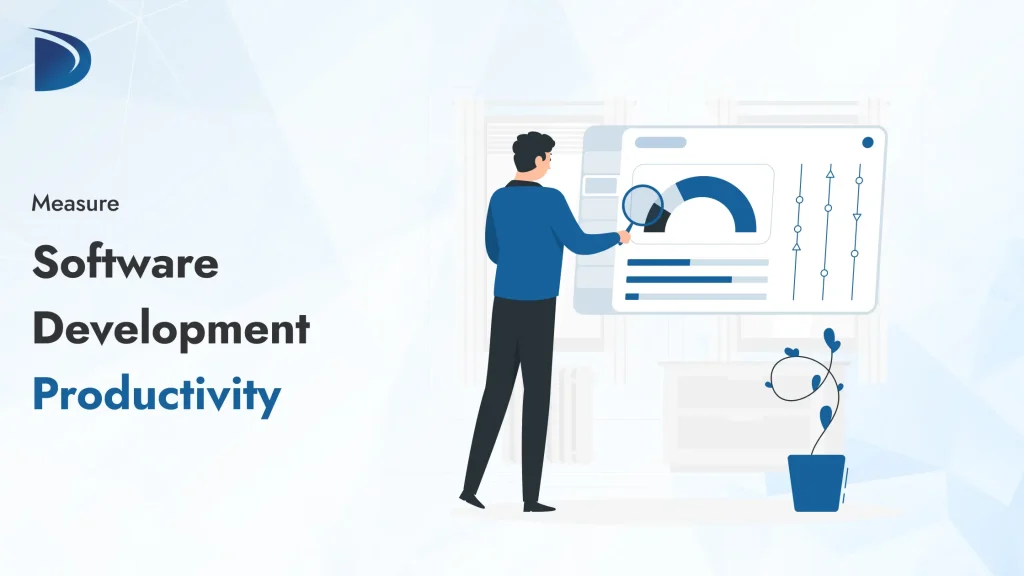Table of Contents
Measuring software development productivity helps teams understand how efficiently they work, deliver better software, and improve business outcomes. But it’s not as simple as counting lines of code or hours worked. This guide explains how to measure productivity in a way that’s easy to understand, practical, and focused on creating value. We’ll cover key metrics, frameworks, and tips to make your team more effective while keeping developers happy.
Why Measure Software Development Productivity?
Productivity in software development isn’t just about writing more code; it’s about delivering quality software that meets user needs quickly and efficiently. Measuring productivity helps you:
- Spot bottlenecks: Find out what’s slowing down your team, like unclear requirements or too many meetings.
- Improve planning: Understand how much work your team can handle to set realistic goals.
- Boost team morale: Happy developers are more productive. Measuring productivity can highlight ways to reduce stress and improve the work environment.
- Increase business value: Deliver better software faster, leading to happier customers and higher revenue.
However, measuring productivity can be tricky. Using the wrong metrics, like lines of code, can lead to poor practices or stress out developers. Instead, focus on metrics that balance speed, quality, and developer satisfaction.
Key Metrics to Measure Software Development Productivity
Some widely used metrics to measure productivity are based on industry frameworks like DORA and SPACE. To avoid unhealthy pressure, these metrics focus on team performance, not individual output.
1. Deployment Frequency
- What it measures: How often your team releases new code to production (e.g., daily, weekly, or monthly).
- Why it matters: Frequent deployments mean your team can deliver features or fixes faster, which is a sign of efficiency.
- How to measure: Track how often your team deploys code to production in a given period.
- Example: A high-performing team might deploy multiple times daily, while a less productive team might deploy once a month.
2. Lead Time for Changes
- What it measures: The time it takes from writing code to getting it live in production.
- Why it matters: Shorter lead times show your team can quickly turn ideas into working software.
- How to measure: Calculate the time between a code commit and its deployment to production.
- Example: Elite teams might have lead times of less than an hour, while others take days or weeks.
3. Change Failure Rate
- What it measures: The percentage of deployments that cause problems, like bugs or outages, in production.
- Why it matters: A low failure rate means your team delivers reliable, high-quality code.
- How to measure: Divide the number of failed deployments by the total number of deployments.
- Example: A strong team has a failure rate below 15%, while a higher rate might signal quality issues.
4. Mean Time to Recovery (MTTR)
- What it measures: How long it takes to fix a failure in production.
- Why it matters: Quick recovery shows your team can handle issues efficiently, reducing user downtime.
- How to measure: Track the average time from when a failure is reported to when it’s resolved.
- Example: Top teams might recover in minutes, while others take hours or days.
5. Developer Satisfaction
- What it measures: How happy and engaged developers are with their work environment and tools.
- Why it matters: Happy developers are more productive and less likely to burn out. Satisfaction impacts code quality and team retention.
- How to measure: Use surveys to ask developers about their workload, tools, and ability to focus on meaningful tasks.
- Example: If 94% of developers rate job happiness as critical to productivity, improving their experience can boost output.
Popular Frameworks for Measuring Productivity
Two well-known frameworks help teams measure productivity effectively: DORA and SPACE. Here’s how they work in simple terms.
1. DORA Framework
The DevOps Research and Assessment (DORA) framework focuses on four key metrics (listed above): deployment frequency, lead time for changes, change failure rate, and MTTR. These metrics measure how quickly and reliably your team delivers software. Based on their results, teams are ranked as elite, high, medium, or low performers. For example, elite teams deploy multiple times a day with low failure rates.
2. SPACE Framework
The SPACE framework, developed by GitHub, Microsoft, and the University of Victoria, looks at five areas:
- Satisfaction and well-being: Are developers happy and supported?
- Performance: Does the software meet quality and business goals?
- Activity: How much work (like commits or pull requests) is done?
- Communication and collaboration: Are team members working well together?
- Efficiency and flow: Can developers focus without interruptions? This framework emphasizes developer experience alongside output, ensuring teams don’t sacrifice happiness for speed.
Tips to Improve Developer Productivity
Once you’re tracking the right metrics, use these tips to boost productivity while keeping your team motivated:
- Reduce Interruptions: Developers work best in a “flow state” of deep focus. Limit meetings and distractions, as 43% of developers only sometimes experience flow due to interruptions.
- Use the Right Tools: Provide developer portals or platforms like Visual LANSA to simplify tasks and reduce setup time. Tools like these can reduce repetitive work and enhance efficiency.
- Focus on Team, Not Individuals: Measuring individual productivity can stress developers and harm teamwork. Focus on team metrics like cycle time or deployment frequency to encourage collaboration.
- Avoid Bad Metrics: Don’t measure lines of code or hours worked. These can lead to poor-quality code or burnout. Instead, prioritize metrics tied to business value, like customer satisfaction or feature delivery.
- Support Developer Well-Being: Regular check-ins and surveys can help you understand developer stress levels. A happy team is more productive, so address issues like overwork or poor tools.
Common Mistakes to Avoid
- Using a single metric: No single number tells the whole story. Combine metrics like DORA and SPACE for a complete picture.
- Ignoring developer feedback: Metrics alone don’t show everything. Talk to your team to understand their challenges and needs.
- Focusing on quantity over quality: More code or commits doesn’t mean better software. Prioritize quality and user impact.
How to Get Started?
- Set Clear Goals: Decide what you want to improve (e.g., faster delivery, fewer bugs, happier developers).
- Choose Metrics: Pick a few metrics from DORA or SPACE that align with your goals.
- Use Tools: Tools like GitHub, LinearB, or Typo can track metrics and provide dashboards for easy monitoring.
- Review Regularly: Check metrics on a weekly or monthly basis to identify trends and implement improvements.
- Involve Your Team: Share metrics with developers and solicit their input to foster trust and collaboration.
Conclusion
Measuring productivity in software development involves striking a balance between speed, quality, and developer satisfaction. Using metrics such as deployment frequency, lead time, and developer satisfaction, along with frameworks like DORA and SPACE, you can gain valuable insights into your team’s performance and make data-driven improvements. Avoid common pitfalls, such as focusing on lines of code, and prioritize tools and practices that help your team work smarter, not harder. Start small, track meaningful metrics, and watch your team deliver better software with less stress.

